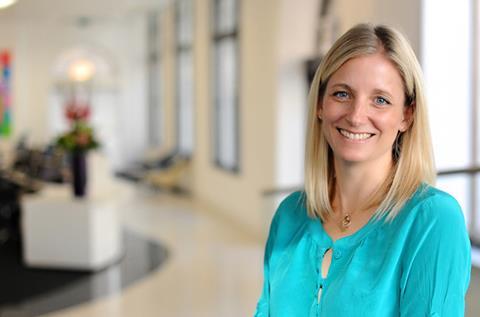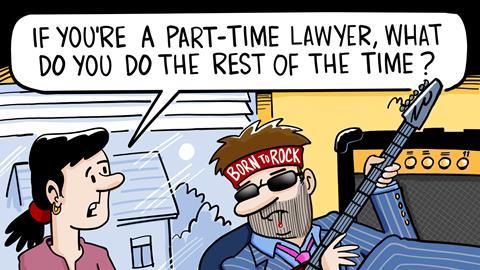Part-time lawyers have long been seen as lacking commitment to their careers and to their clients. But that hackneyed view is changing, reports Marialuisa Taddia
There are no statistics available on the number of solicitors who work on a part-time or other flexible-working basis. But as Julia Waltham, head of policy and public affairs at charity Working Families, observes: ‘There have been positive changes in recent years and we have seen more and more law firms making a concerted effort to implement flexible and family-friendly working policies and practice.’

As the UK’s work-life balance organisation, Working Families counts many law firms among its members. Pinsent Masons was among the top 10 employers in its 2018 benchmark report, together with the Crown Prosecution Service. Allen & Overy, Hogan Lovells and Simmons & Simmons were in the top 30.
‘On a firm-by-firm basis,’ Waltham says, ‘there is a huge appetite to do better, particularly given the fact that Millennials generally place huge importance on work-life balance and flexibility.’ And although there is a legal framework providing a ‘right to request’ flexible working, what many firms are in fact responding to is the need to recruit and retain professionals who want to work different or fewer hours.
Michael Bailey, manager and legal recruitment specialist at Sellick Partnership, says that when he joined the company five years ago recruiting for part-timers was ‘rare’. Professionals who worked part-time typically negotiated this when already established in a role. That is changing for several reasons, Bailey believes. Why so? First, ‘there is a candidate shortage so employers are having to be more flexible to get the right candidate’, he says. Second, ‘employers are starting to realise that candidates want more of a work-life balance’. Third, ‘technology means employees now do more out-of-hours, breaking down the barrier that they will only work the set, part-time hours and that someone else will have to pick up their work’. And fourth, ‘consultant firms are popping up everywhere now, which give the candidate absolute autonomy to work how they see fit’.
On a firm-by-firm basis there is a huge appetite to do better, particularly given the fact that Millennials generally place huge importance on work-life balance and flexibility
Julia Waltham, Working Families
Bailey, who only recruits to private practice, says it is mainly the medium to larger firms that are ‘a little more flexible’ because they have the resources, including the technology, to support part-time working. And some areas of law are better suited to it – 60% to 70% of the roles in private client work are part-time, he estimates.
Benjamin Brooks, a consultant at Hays, covers legal recruitment in the Thames Valley area across in-house, private practice and the public sector. ‘With regard to being contracted to work only three or four days a week, I have found that it is mainly within private practice and smaller law firms, though, on occasion public sector as well. Across the in-house market these are less common, but are more typical when candidates are more senior than the job requires, allowing them to do it more efficiently in less time.’
A common alternative to part-time is remote-working with less rigid working hours, points out Brooks. ‘This approach is a great [compromise] between not having to be in the office, satisfying the needs of the employee, and still being able to complete the required work, satisfying the needs of the employer.’
That is because the legal profession is ‘quite reactive to the needs of clients’, he argues. ‘If you have an emergency and you aren’t accessible, then it will come down to you as the solicitor, even if other team members can cover the work to some degree.’
So to what extent is working part-time – or just flexible hours – a career-limiting move in today’s profession?

‘Employers with that mindset are the ones that are struggling to recruit and retain staff,’ Bailey says.
Indeed, Simmons & Simmons says flexible working has had a positive impact on both attracting and keeping talented lawyers who want the freedom to define a working arrangement that supports their lifestyle.
Laura Farnsworth, a partner in Lewis Silkin’s employment team, says: ‘There are many advantages for both employees and employers. Employees who are able to find a better balance between work and other commitments are more likely to be loyal, committed to the business and less stressed. This leads to a more stable workforce, which improves client service, and reduces the cost of recruiting and training new staff.’
Technology means employees now do more out of hours, breaking down the barrier that they will only work the set, part-time hours and that someone else will have to pick up their work
Michael Bailey, Sellick Partnership
But both employees and employers ‘need to think outside the box’, Bailey says. He cites the recent example of a candidate who wanted to be able to drop off and pick up her children from school, but not to reduce her hours (for example, by working a shorter day in the office, and then picking up some work from home). ‘She was being forced to consider part-time roles as employers don’t work like this,’ Bailey says. ‘But I managed to secure her a home-based role which now enables her to do that. She is considered part-time, but she works as many hours as a full-time employee – and she is paid hourly so does not lose out.’

Jo Crookshank has worked four days a week since her son was born four years ago.
Crookshank is a partner (non-lawyer) in the tax team at Simmons & Simmons who focuses on the technology, media and telecommunications sector, and her particular specialism is VAT. She moved from EY to Simmons & Simmons in September, joining as a partner. ‘Accountancy firms are very hot on flexible working, and so I was doing a four-day week at EY,’ she says. She was ‘not prepared to compromise’ on the shorter working week when the City law firm head-hunted her.
She told them that if they were not interested in offering flexible working then there was ‘no point in having a further conversation’. Instead, Simmons ‘came back straight away and said “absolutely we still want to talk to you we are very happy to offer flexible working”, and so that was a very good start to the conversation,’ Crookshank says. She works Mondays to Thursdays and does not plan to return to a full working week any time soon.
Working part-time also brings benefits to employers. ‘The head space away from the office is quite a creative time for me,’ she says. For example, it is when walking her dog on a Friday morning after dropping off her son at school, that she often comes up with her ‘best ideas about things to do. So not only it is beneficial from a family perspective, [but] also from a productivity perspective’, she says. Part-timers are also able to squeeze more out of less time. It is often said that if you want something done, ask a busy person to do it. ‘The amount of time you spend being productive when you are doing a four-day week is probably equivalent to somebody doing a five-day week,’ she says.
In a profession where the client is king, how does she handle their demands on her day off? First, she does not find clients ‘at all difficult’ about her part-time arrangements. ‘They like working with me and the fact that I am not at the end of the phone every single day, 24 hours a day doesn’t damage that relationship at all.’
At the same time, it is important to be flexible – all the more so because as a partner she runs a business. A case in point is this interview with the Gazette, which she did on a Friday from the car park of her son’s school. She is no different to full-timers at the firm who may occasionally log-on to work at weekends. But equally, ‘if it is starting to encroach upon your non-working day, and you are getting resentful, that’s not a good thing either’. So it is important to ‘know your boundaries and make sure your team understands [them]’, she says. This means delegating to more junior members of her team, and in so doing giving others ‘an opportunity to step up’ – but on the understanding that support is returned if team colleagues are in similar need.

Simmons & Simmons was one of the first major firms to introduce flexible hiring, in 2016. Lawyers can join the firm with a flexible working arrangement in place from day one.
The initiative has been a success: ‘We are increasingly seeing candidates join us on a flexible working arrangement,’ says Joanna Harris, the firm’s CR and diversity manager.
Over six years ago the firm also amended its flexible working policy so that employees don’t need a reason to request it. ‘Historically, flexible working was awarded to people who were juggling childcare arrangements and, actually, we recognised that people want to work flexibly for a whole host of reasons,’ she says.
Flexible working at Simmons & Simmons includes part-time, job-sharing, slightly adjusted hours, and ‘informal’ home-working, by which every one in the firm, including trainees, can work from home up to one day per week.
Harris notes that there now more men who take up shared parental leave and flexible working arrangements. And despite perceptions to the contrary, there are as many transactional lawyers – if not more – working flexibly and from home, as lawyers in other disciplines.
Top tips
For anyone considering more flexible working arrangements, what practical steps should they take?
‘The easiest way to secure a part-time role is to negotiate with your current employer as they are still a rarity,’ Bailey says.
If the employer is concerned about how the arrangement will work, it is a good idea to suggest a trial period and, if it does not work, to suggest alternatives, Farnsworth says. It is also important to think carefully about the impact the proposed working arrangement will have on the business and suggest ways of dealing with any potential negative effect. ‘This will make it easier for your employer to see how the arrangement can work in practice and therefore more likely to agree to it,’ she adds.
Would-be part-timers should not expect to get the job or salary they would like immediately, Brooks warns: ‘You will have to prepare a strong case as to why and how you are going to be able to work to the same ability, but over less time. And you will have to accept it will take longer for the right job to come up.’
There are different ways of working flexibly, and part-time is only one of them. ‘The locum route is a good compromise,’ Bailey says. ‘Many of my locums work a couple of weeks, then take a couple of weeks off. Some only work throughout the busy summer months and then have the winter off. Some even go abroad for the winter.’
If you are opting for part-time, job-sharing is a way to ensure continuous client cover. Farnsworth says: ‘It can be difficult for lawyers to genuinely work part-time because work often needs to be done on their non-working day. This can be stressful, particularly if you spend your non-working day with young children.’
It also helps to be flexible with your flexible working, Harris says. It means answering the odd email or taking a call on a non-working day, just as full-time lawyers do at weekends.
‘Communication is key to making [flexible working] a success,’ Harris says. It means being clear with your employer about what you want in terms of work-life balance, and then communicating your flexible working arrangements to your team and your clients.
Last, it is important to remember that nothing ventured is nothing gained. ‘Don’t be afraid to ask for what you want,’ says Simmons & Simmons partner Jo Crookshank. The firm will either agree to it or find a compromise ‘because they want to make it work, so be brave’, she says.

Laura Farnsworth is a partner in the employment team at Lewis Silkin. She has worked four-and-a-half days a week since returning from her first maternity leave in 2009. She works from home on a Friday morning and takes the afternoon off so that she can collect her children from school.
Farnsworth also heads up Rockhopper, the firm’s low-cost, fixed-fee HR and employment law support service which was launched in July 2014 in response to ‘pressure’ from clients. Rockhopper provides an advice line and fixed-fee defence of employment tribunal claims. It was ‘designed primarily for businesses in the retail and hospitality sector, with a high number of low-paid staff’, Farnsworth says.
Most firms providing similar services use paralegals or very junior lawyers, Farnsworth explains, as that is usually the ‘most cost-effective’. But ‘our priority was to provide a high-quality service that clients associated with Lewis Silkin’, she says. ‘Around the same time, we realised we were at risk of losing some of our senior, talented lawyers because they wanted to work in a different way. Either they wanted to live in a location not commutable to any of our offices, or they wanted to find a better balance between work and family life. We quickly concluded that this provided the solution.’
The Rockhopper lawyers work exclusively from home on part-time hours they choose for themselves and on different terms to the lawyers in the firm’s ‘core team’. This means that they are employees, but they have no fee targets, no obligations to carry out non-chargeable work, such as business development, and are on a reduced salary.
Farnsworth says: ‘It has been particularly attractive to parents, predominantly women, with young children, but it’s also attractive to anyone who wants to continue a high-quality career as an employment lawyer but work in a different way.’
Now with 14 lawyers, Rockhopper’s revenue grew by 120% in its third year (to 31 March 2018), in part owing to the abolition of employment tribunal fees in the summer of 2017. This led to an increase in low-value ‘routine’ claims that are ‘ideal’ for the Rockhopper service, Farnsworth says.

Simmons & Simmons’ Adaptive, launched in October 2014, allows the firm to provide secondees at short notice to clients by tapping into a growing contingent of ‘talented’ lawyers who want to work differently.
Sarah Thompson, head of the Adaptive service, says the nature of secondments has changed in recent years – they can last up to 12 months and clients often require seconded senior lawyers.
She says that losing managing associates or partners to the client for 12 months is ‘increasingly very challenging’ for businesses.
Adaptive is a team of consultant lawyers – 75% of whom are on client secondments, with the remaining 25% doing fee-earning work internally for the firm.
Thompson says: ‘All lawyers are self-employed and they enter into a non-exclusive relationship with Simmons & Simmons which means we do not limit them to just working with us. They have the flexibility to go off and have other relationships, and have their own clients as well.’ Nevertheless, each consultant goes through ‘quite a stringent recruitment process’, she adds. ‘They are high-quality lawyers who have been pre-selected and assessed by us to meet the standards you would expect from Simmons & Simmons.’
The consultants are ‘fully supported’ by partners and other senior members of the firm, and have access to its know-how and training.
‘Consultants have complete ownership over letting us know when they are available for work, what their work pattern is, what assignments they want to do and where they are based,’ she says, pointing to a US-based consultant who is currently undertaking a project for the London office. The firm recently introduced new technology to support its team of ‘Adaptives’.
Consultants are not just working parents. ‘The reasons for working in this way are very diverse, very weird, and very wonderful,’ Thompson says. The team includes interior designers, fintech start-up entrepreneurs, keen travellers and lawyers who want to try out different practice areas.
Marialuisa Taddia is a freelance journalist






























1 Reader's comment